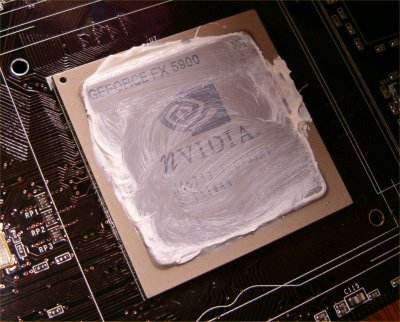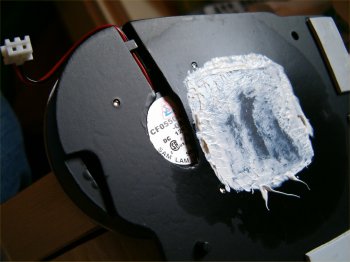Point of View GeForce FX 5900XT
Let's take a look at the card itself. Being NV35-based (apparently, more on that later), it shares its component layout with most other NV35-based cards from dozens of other manufacturers.Click for an image of the back side of the card (~44KB).

The card presentation is something PoV are proud of, kitting it out in a stylish black PCB with heatsink to match, decorated with our familiar lizard friend. The top of the card is decorated, since it seems to serve nothing more than an aesthetic purpose, with a metallic strip across the top board edge.
Installed in a stand-up ATX chassis with a case window, you'd see the metallic strip and sparse backside of the board, making it stand out from most other competing cards.
With 128MB of memory, there's only DRAM chips on the GPU side of the board. This means we've got the usual dual purpose cooler, cooling both GPU and DRAM devices, with no discrete cooling on the back side of the board. Technically it's a single slot cooler but PoV, in the manual, recommend you leave the PCI slot, next to the AGP slot that the card will occupy, free.

The GPU uses the latest packaging type available to NVIDIA at TSMC. It's different from the first NV3x packages seen at launch, with no raised heatspreader with a raised surround, instead using a completely flat, seemingly ceramic, package covering the entire GPU area.
The fan on the heatsink is usually found in laptop cooling solutions. It's not the quietest fan and has no apparent speed control, related to heat output or otherwise, but it's not ear splitting either. Google didn't want to help find any specific decibel rating for the fan, but I'd estimate it being ~45dBA, based on the ratings of other fans on recent boards.

It's pleasing to see PoV use plenty of thermal paste between the GPU package and the heatsink. Don't be fooled by the apparent amount used, it just looks excessive due to my fumblings taking the cooler off for a closer look underneath. The DRAMs interface with the heatsink by means of thermal pads. Adjacent DRAMs share a thermal pad. Hynix 2.8ns BGA devices power the PoV, rated to just over 700MHz DDR at that particular refresh.
A quick shot of the standard DVI-I, S-Video output and VGA ports before we examine the bundle.










